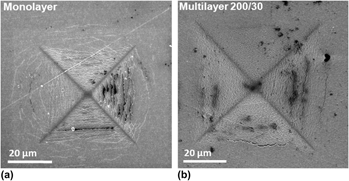Crossref Citations
This article has been cited by the following publications. This list is generated based on data provided by
Crossref.
Verma, Nisha
and
Jayaram, Vikram
2014.
Role of interface curvature on stress distribution under indentation for ZrN/Zr multilayer coating.
Thin Solid Films,
Vol. 571,
Issue. ,
p.
283.
Payán-Díaz, S.
De La Cruz, W.
Talamantes-Soto, R.
Hurtado-Macías, A.
and
Hirata, G.A.
2016.
Effect of volume fraction on mechanical properties of Zr/ZrN multilayer systems.
Ceramics International,
Vol. 42,
Issue. 16,
p.
18806.
Guan, Xiaoyan
Wang, Yongxin
Zhang, Guangan
Jiang, Xin
Wang, Liping
and
Xue, Qunji
2017.
Microstructures and properties of Zr/CrN multilayer coatings fabricated by multi-arc ion plating.
Tribology International,
Vol. 106,
Issue. ,
p.
78.
Chakrabarti, Tamoghna
Verma, Nisha
and
Manna, Sukriti
2017.
Grain boundary driven Plateau–Rayleigh instability in multilayer nanocrystalline thin film: A phase-field study.
Materials & Design,
Vol. 119,
Issue. ,
p.
425.
Pogrebnjak, A. D.
Kravchenko, Ya. O.
Bondar, O. V.
Zhollybekov, B.
and
Kupchishin, A. I.
2018.
Structural Features and Tribological Properties of Multilayer Coatings Based on Refractory Metals.
Protection of Metals and Physical Chemistry of Surfaces,
Vol. 54,
Issue. 2,
p.
240.
Zhang, Xiaoman
Namakian, Reza
Meng, Andrew C.
Moldovan, Dorel
and
Meng, W.J.
2022.
Size-dependent tensile failure of epitaxial TiN/Cu/TiN sandwich pillar structures: A combined experimentation – Atomistic simulation study.
Materials Science and Engineering: A,
Vol. 855,
Issue. ,
p.
143889.
Mishra, Ashwini Kumar
Gopalan, Hariprasad
Hans, Marcus
Kirchlechner, Christoph
Schneider, Jochen M.
Dehm, Gerhard
and
Jaya, Balila Nagamani
2022.
Strategies for damage tolerance enhancement in metal/ceramic thin films: Lessons learned from Ti/TiN.
Acta Materialia,
Vol. 228,
Issue. ,
p.
117777.
Wang, Huanhuan
Lin, Naiming
Nouri, Meisam
Liu, Zhiqi
Yu, Yuan
Zeng, Qunfeng
Ma, Guanshui
Fan, Jianfeng
Li, Dongyang
and
Wu, Yucheng
2023.
Improvement in surface performance of stainless steel by nitride and carbon-based coatings prepared via physical vapor deposition for marine application.
Journal of Materials Research and Technology,
Vol. 27,
Issue. ,
p.
6021.
